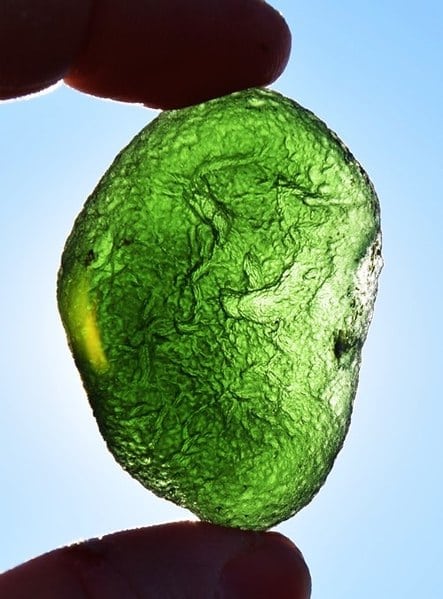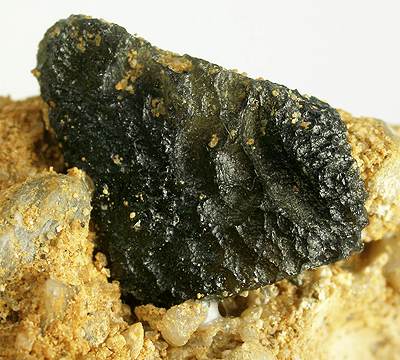
Moldavite is a projectile rock formed by meteor impact and found primarily around southern Germany. It is believed to have been formed around 15 million years ago. The rock is forest green, blue-green, or olive green in coloration and is usually transparent. It has swirls or bubbles within it that can help distinguish it from imitations.
The Formation Of Moldavite
Around 1900 it was noticed that pieces of moldavite which were gravel-sized displayed interesting wrinkles and pittings on their surface. This likely wasn’t the result of erosion, rather they resembled the markings found on other types of rocks pulled from meteorite landing regions. The material was initially determined as coming from space, though scientists now believe it is terrestrial in nature.
Moldavite is a rock that results from meteorite impact, and these rocks are dubbed tektites. Tektites are rocks that are gravel-sized and typically gray, brown, or green. They are superficially similar to volcanic glass, but they have certain characteristics, such as the lack of any small grains in the rock, that distinguish them from volcanic glass.

Photo: Rob Lavinsky, iRocks.com – CC-BY-SA-3.0
Moldavite, and other tektites have low water content and difficult fusibility. For these reasons, current Earth scientists believe that moldavite was probably formed around 14.7 to 15 million years ago when a massive meteorite fell in what is now Bavaria, Germany. When the metorite impacted the ground it sent material flying everywhere and the material likely cooled while airborne, resulting in its unique look. Vladimir Bouska, in the book Moldavites: The Czech Tektites, explains that the process of fusion and the throwing of the tektite glass material actually happened before the impact of the meteorite, within a short time frame. The impact actually briefly tears the atmosphere apart and the tektites are formed within a vacuum bubble that quickly disappears.
Properties Of Moldavite
Moldavite can come in a variety of different shapes, much like other tektites. The shapes of moldavite include discs, spheres, lenses, rods, cylinders, ellipsoids, and others. The shape of the moldavite is caused by the rotation of melting mineral in the atmosphere and scientists have managed to reproduce the shapes in aerodynamic tunnels that mimic the conditions which formed the moldavite. Moldavite’s surface features include various bumps, cavities, hollows and grooves, and these features can often be created by geological processes. For example, rivers and streams may transport samples of moldavite away from the mineral’s original site, and in doing so shape them.
Moldavite’s chemical formula is SiO2(+Al2O3). Moldavite has properties very similar to other kinds of glass, and it also has a Mohs hardness value of approximately 5.5 to 7. The Mohs scale is a scale that tracks the scratch resistance of different minerals, and is one of the ways that materials scientists track hardness. The Mohs scale runs from 1 to 10, with ten being the hardest. Soft metals like gold and silver have a Mohs rating of between 2.5 to 3, while steel has a Mohs rating of between 4 to 4.5. In terms of other minerals, quartz has a Mohs value of 7, while Topaz has a Mohs value of 8. Diamond is one of the hardest materials in the world, with a Mohs value of 10.
Location Of Moldavite Finds
Most moldavite has been found in a region of Europe that covers western Moravia, the Cheb Basin, northwest Austria, Lusatia and southern Bohemia. Isotopic analysis of moldavite samples reveals that moldavite has a beryllium-10 isotope composition much like the beryllium-10 composition of tektites found in Australia and tektites found on the Ivory Coast.
Almost every known piece of moldavite (99% of it), has been found around South Bohemia. The remaining moldavite finds were pulled from a South Moravian area. A handful of finds were made near Dresden, in Northern Austria, and in the Cheb basin. The most prominent locations for moldavite are a strip that runs northwest to southeast along the western edge of the České Budějovice Basin. Most of the finds were located within the sandy gravel areas of this region.
An interesting phenomenon is that the color of moldavites found in Moravia is usually different from the color of moldavite found in Bohemia. Most moldavite has a greenish color, but Moravian moldavite tends to be brownish. Though finds of moldavite aren’t anywhere near as common in the Moravia sites as in the Bohemia sites, the average weight of moldavites found in Moravia is substantially higher than those found in Bohemia. The oldest known moldavite sediments are located between Třebíč and Slavice, while the other moldavite regions in southern Moravia are near Pleistocene rivers and Miocene sediments.
Moldavite Grades
Estimates put the total amount of moldavite scattered around the world at around 275 tons. Moldavite is classified into three different grades: high quality, medium quality, and regular quality. All three grades can be distinguished by appearance with the different grades having different attributes. Regular grade pieces of moldavite are usually much darker than and have more saturation than the medium quality or high-quality pieces. The surface of regular grade pieces also has much more pitting and weathering than the other grades. Medium-quality moldavite stones tend to be more translucent than regular grade stones, and they are often used to create pieces of jewelry. High-grade pieces (sometimes called museum-grade pieces) are more translucent than even medium-quality stones and they often have a notable fern-like pattern within them.
History Of Moldavite
Moldavite was initially introduced to the scientific community sometime around 1786 by professor Josef Mayer of the Prague University. The meeting was at the Bohemian Scientific Society. The term moldavite wouldn’t be coined until much later, around 1836. The term comes from the Moldau river in Bohemia, referencing where the first pieces of moldavite were found.
A moldavite museum, the Muzeum Vltavínů, contains many high-grade pieces and it can be found in Český Krumlov, Czech Republic. There’s also a Moldavite association which exists in Slovenia. The association’s purpose is to promote moldavites (along with other examples of tektite) to museums and researchers from around the world.









